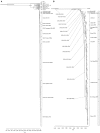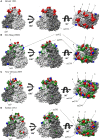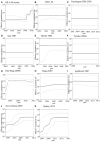Molecular Evolution of the VP1 Gene in Human Norovirus GII.4 Variants in 1974-2015
- PMID: 29259596
- PMCID: PMC5723339
- DOI: 10.3389/fmicb.2017.02399
Molecular Evolution of the VP1 Gene in Human Norovirus GII.4 Variants in 1974-2015
Abstract
Human norovirus (HuNoV) is a leading cause of viral gastroenteritis worldwide, of which GII.4 is the most predominant genotype. Unlike other genotypes, GII.4 has created various variants that escaped from previously acquired immunity of the host and caused repeated epidemics. However, the molecular evolutionary differences among all GII.4 variants, including recently discovered strains, have not been elucidated. Thus, we conducted a series of bioinformatic analyses using numerous, globally collected, full-length GII.4 major capsid (VP1) gene sequences (466 strains) to compare the evolutionary patterns among GII.4 variants. The time-scaled phylogenetic tree constructed using the Bayesian Markov chain Monte Carlo (MCMC) method showed that the common ancestor of the GII.4 VP1 gene diverged from GII.20 in 1840. The GII.4 genotype emerged in 1932, and then formed seven clusters including 14 known variants after 1980. The evolutionary rate of GII.4 strains was estimated to be 7.68 × 10-3 substitutions/site/year. The evolutionary rates probably differed among variants as well as domains [protruding 1 (P1), shell, and P2 domains]. The Osaka 2007 variant strains probably contained more nucleotide substitutions than any other variant. Few conformational epitopes were located in the shell and P1 domains, although most were contained in the P2 domain, which, as previously established, is associated with attachment to host factors and antigenicity. We found that positive selection sites for the whole GII.4 genotype existed in the shell and P1 domains, while Den Haag 2006b, New Orleans 2009, and Sydney 2012 variants were under positive selection in the P2 domain. Amino acid substitutions overlapped with putative epitopes or were located around the epitopes in the P2 domain. The effective population sizes of the present strains increased stepwise for Den Haag 2006b, New Orleans 2009, and Sydney 2012 variants. These results suggest that HuNoV GII.4 rapidly evolved in a few decades, created various variants, and altered its evolutionary rate and antigenicity.
Keywords: GII.4; Norovirus; VP1; bioinformatics; molecular evolution.
Figures






Similar articles
-
Molecular Evolutionary Analyses of the RNA-Dependent RNA Polymerase Region in Norovirus Genogroup II.Front Microbiol. 2018 Dec 18;9:3070. doi: 10.3389/fmicb.2018.03070. eCollection 2018. Front Microbiol. 2018. PMID: 30619155 Free PMC article.
-
Molecular Evolution of the RNA-Dependent RNA Polymerase and Capsid Genes of Human Norovirus Genotype GII.2 in Japan during 2004-2015.Front Microbiol. 2017 Apr 25;8:705. doi: 10.3389/fmicb.2017.00705. eCollection 2017. Front Microbiol. 2017. PMID: 28487679 Free PMC article.
-
Genetic Analysis of Norovirus GII.4 Variant Strains Detected in Outbreaks of Gastroenteritis in Yokohama, Japan, from the 2006-2007 to the 2013-2014 Seasons.PLoS One. 2015 Nov 6;10(11):e0142568. doi: 10.1371/journal.pone.0142568. eCollection 2015. PLoS One. 2015. PMID: 26544040 Free PMC article.
-
Characterization of GII.4 noroviruses circulating among children with acute gastroenteritis in Pune, India: 2005-2013.Infect Genet Evol. 2016 Jan;37:163-73. doi: 10.1016/j.meegid.2015.11.016. Epub 2015 Nov 27. Infect Genet Evol. 2016. PMID: 26611824
-
Molecular epidemiology and temporal evolution of norovirus associated with acute gastroenteritis in Amazonas state, Brazil.BMC Infect Dis. 2018 Apr 2;18(1):147. doi: 10.1186/s12879-018-3068-y. BMC Infect Dis. 2018. PMID: 29606095 Free PMC article.
Cited by
-
Molecular Evolution of the Fusion Protein (F) Gene in Human Respirovirus 3.Front Microbiol. 2020 Jan 15;10:3054. doi: 10.3389/fmicb.2019.03054. eCollection 2019. Front Microbiol. 2020. PMID: 32010105 Free PMC article.
-
Norovirus Replication in Human Intestinal Epithelial Cells Is Restricted by the Interferon-Induced JAK/STAT Signaling Pathway and RNA Polymerase II-Mediated Transcriptional Responses.mBio. 2020 Mar 17;11(2):e00215-20. doi: 10.1128/mBio.00215-20. mBio. 2020. PMID: 32184238 Free PMC article.
-
Norovirus GII.2[P16] strain in Shenzhen, China: a retrospective study.BMC Infect Dis. 2021 Oct 30;21(1):1122. doi: 10.1186/s12879-021-06746-9. BMC Infect Dis. 2021. PMID: 34717565 Free PMC article.
-
Molecular evolution of the capsid (VP1) region in human norovirus genogroup II genotype 3.Heliyon. 2020 May 3;6(5):e03835. doi: 10.1016/j.heliyon.2020.e03835. eCollection 2020 May. Heliyon. 2020. PMID: 32395646 Free PMC article.
-
Broad-range and effective detection of human noroviruses by colloidal gold immunochromatographic assay based on the shell domain of the major capsid protein.BMC Microbiol. 2021 Jan 11;21(1):22. doi: 10.1186/s12866-020-02084-z. BMC Microbiol. 2021. PMID: 33430771 Free PMC article.
References
-
- Añez G., Grinev A., Chancey C., Ball C., Akolkar N., Land K. J., et al. . (2013). Evolutionary dynamics of West Nile virus in the United States, 1999-2011: phylogeny, selection pressure and evolutionary time-scale analysis. PLoS Negl. Trop. Dis. 7:e2245. 10.1371/journal.pntd.0002245 - DOI - PMC - PubMed
-
- Allen D. J., Trainor E., Callaghan A., O'Brien S. J., Cunliffe N. A., Iturriza-Gómara M. (2016). Early detection of epidemic GII-4 norovirus strains in UK and Malawi: role of surveillance of sporadic acute gastroenteritis in anticipating global epidemics. PLoS ONE 11:e0146972. 10.1371/journal.pone.0146972 - DOI - PMC - PubMed
LinkOut - more resources
Full Text Sources
Other Literature Sources

